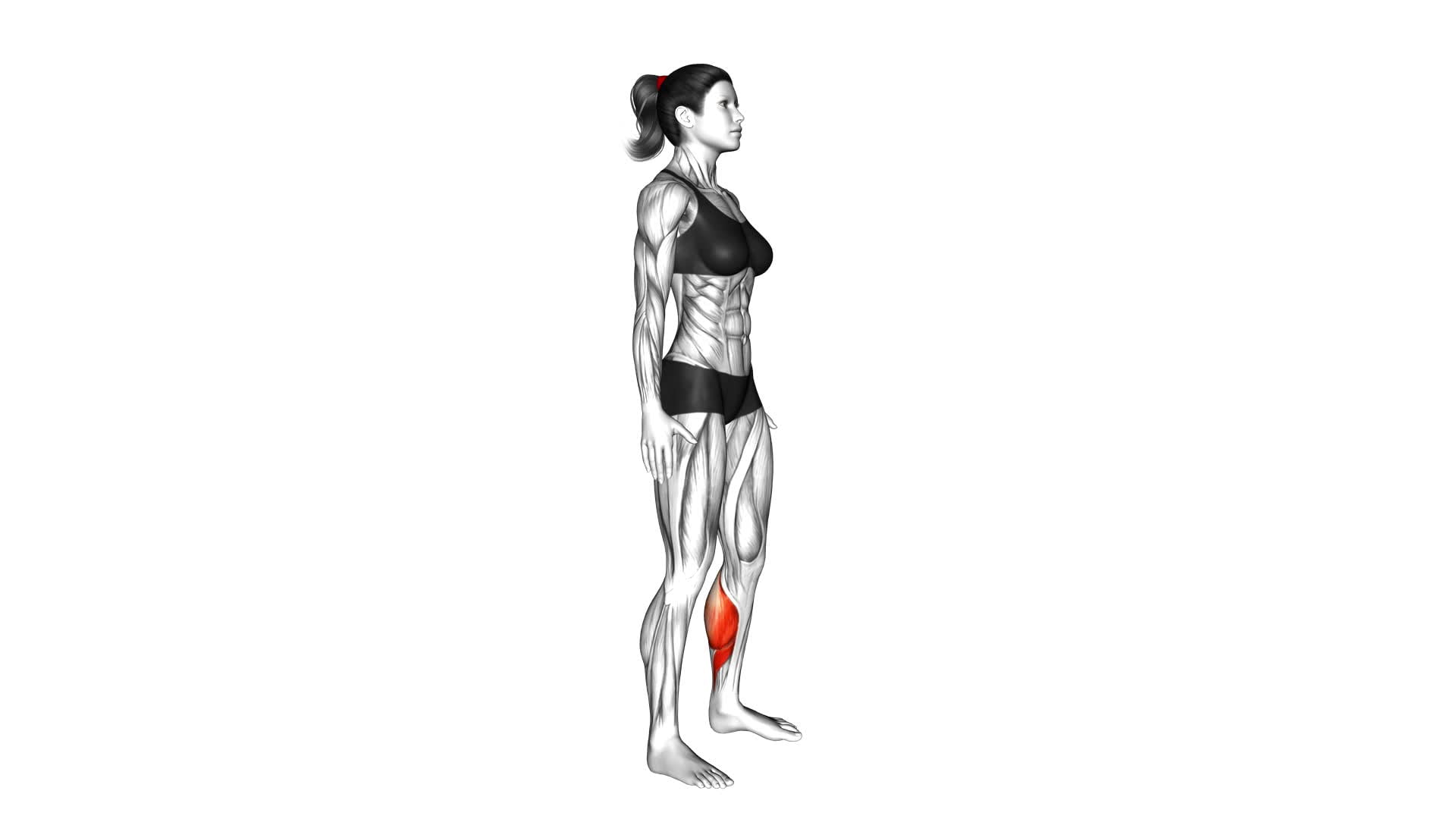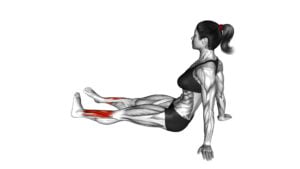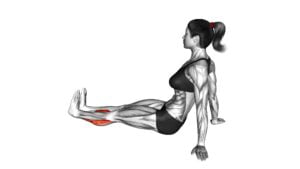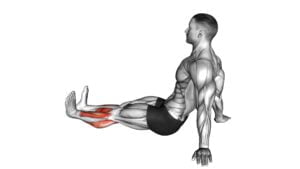Feet and Ankles Side-to-Side Stretch (female) – Video Exercise Guide & Tips

Are you looking for a simple yet effective stretch to target your feet and ankles? Look no further than the Feet and Ankles Side-to-Side Stretch.
Watch This Exercise Video
In this video exercise guide, we'll show you the proper form and technique for this stretch, along with precautions and modifications specifically for women.
Learn how to avoid common mistakes and get the most out of this stretch, and discover how to incorporate it into your fitness routine.
Let's get started!
Key Takeaways
- Enhanced flexibility and improved stability in feet and ankles
- Increased range of motion for greater flexibility and movement
- Strengthening of muscles surrounding feet and ankles for improved stability and balance
- Rehabilitation aid for ankle sprains or injuries
Benefits of the Feet and Ankles Side-to-Side Stretch
You will experience enhanced flexibility and improved stability in your feet and ankles through the Feet and Ankles Side-to-Side Stretch. This exercise offers numerous benefits that can greatly contribute to your overall foot and ankle health.
By engaging in this stretch, you can increase the range of motion in your feet and ankles, allowing for greater flexibility and movement. This is particularly beneficial for individuals who engage in activities that require agility and quick foot movements, such as athletes or dancers.
Additionally, this stretch helps to strengthen the muscles surrounding your feet and ankles, leading to improved stability and balance. This can be especially advantageous for those who've suffered from ankle sprains or other injuries, as it can aid in the rehabilitation process.
Furthermore, the Feet and Ankles Side-to-Side Stretch can be easily modified to accommodate different fitness levels and needs. By adjusting the intensity or duration of the stretch, individuals of all abilities can reap the benefits of this exercise.
Whether you're a seasoned athlete or just starting your fitness journey, incorporating the Feet and Ankles Side-to-Side Stretch into your routine can provide significant advantages for your foot and ankle health.
Proper Form and Technique for the Stretch
To ensure proper form and technique for the Feet and Ankles Side-to-Side Stretch, it's important to focus on alignment and stability. Keep your feet hip-width apart and maintain a neutral spine throughout the exercise.
Avoid common mistakes such as leaning forward or allowing your knees to collapse inward. By paying attention to these points, you can maximize the effectiveness of the stretch and minimize the risk of injury.
Alignment and Stability Tips
Ensure proper alignment and stability by maintaining a neutral spine throughout the Feet and Ankles Side-to-Side Stretch. Alignment tips are crucial for maximizing the effectiveness of this stretch and preventing injuries.
Start by standing with your feet hip-width apart and your knees slightly bent. Keep your spine straight and engage your core muscles to stabilize your body.
As you move your feet and ankles from side to side, make sure to maintain the alignment of your hips, knees, and ankles. Avoid excessive twisting or leaning of your upper body, as this can compromise your stability and put unnecessary strain on your joints.
Common Mistakes to Avoid
To avoid common mistakes and ensure proper form and technique for the Feet and Ankles Side-to-Side Stretch, it's important to maintain alignment and stability throughout the exercise. By doing so, you can maximize the benefits of this stretch while minimizing the risk of injury. Here are some common mistakes to avoid:
- Rounding your back: To prevent strain on your spine and maintain proper alignment, keep your back straight and shoulders relaxed during the stretch.
- Overstretching: While it's important to challenge your flexibility, avoid pushing yourself too far. Gradually increase the range of motion over time to prevent injuries.
- Neglecting your feet: Pay attention to your feet placement during the stretch. Keep them parallel and grounded to maintain stability and ensure an effective stretch.
Precautions and Modifications for Women
For women, it's important to take certain precautions and make modifications while performing the Feet and Ankles Side-to-Side Stretch. This exercise can provide numerous benefits, such as improving flexibility, strengthening the lower body, and reducing the risk of injury. However, it's crucial to consider the unique physiological differences that women may have, especially in the lower body, before attempting this stretch.
Firstly, it's essential to warm up properly before engaging in any stretching routine. This helps to increase blood flow to the muscles, making them more pliable and reducing the risk of strain or injury. Additionally, women who are pregnant or have recently given birth should consult with their healthcare provider before attempting this stretch. Pregnancy can cause hormonal changes that affect joint stability, and certain modifications may be necessary to avoid overstretching or straining the muscles.
Furthermore, women with a history of ankle or foot injuries should exercise caution when performing this stretch. It's advisable to start with smaller movements and gradually increase the range of motion over time. Additionally, if you experience any pain or discomfort during the stretch, it's important to stop immediately and seek guidance from a qualified healthcare professional.
Common Mistakes to Avoid During the Stretch
When performing the Feet and Ankles Side-to-Side Stretch, it's important to be aware of common mistakes that you should avoid to ensure proper form and maximize the benefits of the exercise. By avoiding these mistakes, you can reduce the risk of injuries and increase your flexibility effectively.
Here are some common mistakes to watch out for:
- Rushing the stretch: It's crucial to take your time and perform the stretch slowly and steadily. Avoid rushing through the movement, as it can lead to improper form and increase the risk of straining your muscles or joints.
- Overstretching: While it's important to push yourself and challenge your flexibility, it's equally important to listen to your body's limits. Avoid pushing yourself too far beyond your comfort zone, as it can result in muscle strains or other injuries.
- Neglecting proper alignment: During the stretch, ensure that your feet and ankles are properly aligned. Avoid allowing your knees to collapse inward or outward, as it can put unnecessary stress on your joints. Focus on maintaining a neutral alignment throughout the exercise.
- Forgetting to breathe: Breathing is essential during any stretch or exercise. Avoid holding your breath and remember to breathe deeply and exhale as you move through the stretch. This will help relax your muscles and enhance the effectiveness of the exercise.
Tips for Getting the Most Out of the Stretch
To get the most out of the Feet and Ankles Side-to-Side Stretch, it's important to focus on proper form. Make sure to keep your feet parallel and your ankles aligned with your knees throughout the stretch.
Additionally, controlling your breath can help you deepen the stretch and relax your muscles.
Lastly, it's recommended to hold the stretch for at least 30 seconds on each side to fully reap the benefits.
Proper Form Importance
Ensure you maintain proper form to maximize the benefits of the Feet and Ankles Side-to-Side Stretch. Proper form is crucial when it comes to stretching as it not only helps prevent injuries but also ensures that you're targeting the right muscles and getting the most out of your workout.
Here are some tips to help you maintain correct form during the Feet and Ankles Side-to-Side Stretch:
- Keep your back straight: Maintaining a straight back will help you avoid rounding your shoulders and maintain proper alignment throughout the stretch.
- Engage your core: By engaging your core muscles, you stabilize your body and enhance the effectiveness of the stretch.
- Control your movements: Slow and controlled movements are key to maintaining proper form and allowing your muscles to stretch gradually.
Breath Control Techniques
Breathe deeply and rhythmically to enhance the effectiveness of the stretch. Incorporating breathing exercises and relaxation techniques into your stretching routine can greatly improve your overall experience and results. By focusing on your breath, you can increase your oxygen intake, relax your muscles, and release tension throughout your body.
As you begin the feet and ankles side-to-side stretch, take a deep breath in, filling your lungs completely. As you exhale, gently lean to one side, feeling a gentle stretch along the inner part of your legs. Inhale again, and as you exhale, return to the starting position. Repeat this process on the other side.
Stretch Duration Recommendations
To maximize the effectiveness of the feet and ankles side-to-side stretch, it's recommended that you hold the stretch for 20-30 seconds on each side. This duration allows your muscles and connective tissues to gradually lengthen and loosen, promoting flexibility and reducing the risk of injury.
Here are some tips for maximizing flexibility during the stretch:
- Focus on your breathing: Take deep breaths in and out to help relax your body and deepen the stretch.
- Engage your core: By activating your core muscles, you can stabilize your body and enhance the stretch.
- Visualize the stretch: Imagine your feet and ankles moving further apart with each repetition, visualizing the desired range of motion.
- Consistency is key: Incorporate the feet and ankles side-to-side stretch into your regular stretching routine to improve flexibility over time.
Incorporating the Feet and Ankles Side-To-Side Stretch Into Your Routine
To effectively incorporate the Feet and Ankles Side-To-Side Stretch into your routine, it's important that you start with a proper warm-up. This will help prepare your muscles and joints for the stretching exercises, reducing the risk of injury. Before you begin, make sure to wear comfortable clothing and find a quiet space where you can focus on your stretches without distractions.
When performing the Feet and Ankles Side-To-Side Stretch, you can incorporate modifications to suit your individual needs. If you find it difficult to reach your toes, you can use a towel or stretch band to assist you. Simply wrap the towel or band around the ball of your foot and gently pull towards you until you feel a stretch in your calf and ankle.
Breath control techniques can also enhance the effectiveness of this stretch. As you move your feet and ankles from side to side, inhale deeply through your nose and exhale slowly through your mouth. This will help relax your muscles and promote a deeper stretch.
It is important to listen to your body and not push yourself too hard. If you start feeling any pain or discomfort, ease off the stretch and consult with a healthcare professional if necessary.
Frequently Asked Questions
Can Men Also Perform the Feet and Ankles Side-To-Side Stretch?
Yes, men can also perform the feet and ankles side-to-side stretch. This stretch is beneficial for both men and women, as it helps improve flexibility and mobility in the feet and ankles.
However, it's important to note that modifications may be necessary for different body types. It's always a good idea to consult with a fitness professional or physical therapist to ensure you're performing the stretch correctly and safely for your specific needs.
How Long Should I Hold the Stretch on Each Side?
To improve flexibility in your feet and ankles, it's important to hold the stretch on each side for an adequate amount of time. Regular stretching for your feet and ankles can have numerous benefits, such as increased range of motion and reduced risk of injury.
Is It Normal to Feel Discomfort or Tightness While Performing This Stretch?
It's not uncommon to experience some discomfort or tightness while doing this stretch. This could be due to tight muscles or limited flexibility in your feet and ankles.
It's important to listen to your body and not push past a point where you feel pain. If the discomfort persists or worsens, it may be a good idea to consult with a healthcare professional or a certified trainer for guidance and modifications to the exercise.
Can This Stretch Help With Plantar Fasciitis or Other Foot Conditions?
Stretching techniques can be beneficial for foot conditions like plantar fasciitis. Regular stretching can help improve flexibility, reduce tightness, and alleviate discomfort in the feet.
By incorporating exercises that target the feet and ankles, such as the side-to-side stretch, you can specifically target the muscles and ligaments in that area. This can help increase range of motion, improve circulation, and provide relief from common foot conditions.
Remember to consult with a healthcare professional for personalized advice.
Can I Perform This Stretch if I Have Had Ankle or Foot Surgery in the Past?
Yes, you can perform this stretch after ankle or foot surgery.
However, it's important to modify the exercise to accommodate your post-surgery condition.
Consult with your healthcare provider or physical therapist for specific modifications that suit your individual needs.
They'll be able to guide you on how to safely and effectively perform this stretch without causing any harm or discomfort to your surgically treated area.
Conclusion
Incorporating the feet and ankles side-to-side stretch into your routine can greatly benefit women by improving flexibility and mobility in the lower body. By following proper form and technique, and avoiding common mistakes, this stretch can help prevent injuries and promote overall foot and ankle health.
Additionally, incorporating tips for getting the most out of the stretch can enhance its effectiveness. Make sure to consult with a healthcare professional before starting any new exercise routine.

Author
Years ago, the spark of my life’s passion ignited in my mind the moment I stepped into the local gym for the first time. The inaugural bead of perspiration, the initial endeavor, the very first surge of endorphins, and a sense of pride that washed over me post-workout marked the beginning of my deep-seated interest in strength sports, fitness, and sports nutrition. This very curiosity blossomed rapidly into a profound fascination, propelling me to earn a Master’s degree in Physical Education from the Academy of Physical Education in Krakow, followed by a Sports Manager diploma from the Jagiellonian University. My journey of growth led me to gain more specialized qualifications, such as being a certified personal trainer with a focus on sports dietetics, a lifeguard, and an instructor for wellness and corrective gymnastics. Theoretical knowledge paired seamlessly with practical experience, reinforcing my belief that the transformation of individuals under my guidance was also a reflection of my personal growth. This belief holds true even today. Each day, I strive to push the boundaries and explore new realms. These realms gently elevate me to greater heights. The unique combination of passion for my field and the continuous quest for growth fuels my drive to break new ground.







